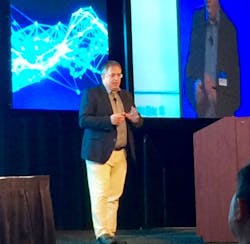To prepare for the Industrial Internet of Things (IIoT), there is an important first step for organizations: Digitalization.
That was the message from Siemens executives at this week’s Siemens PLM industry analyst conference in Boston, who recapped their several-year journey of acquisitions and product portfolio integration in order to align product lifecycle management (PLM) software with the company’s production and automation technologies. Digitalization, at its core, is the use of digital technologies to change a business model—moving from silos of enterprise and operations tools into a connected digital business. That, in turn, creates a new business model and new service-based revenue opportunities that take advantage of the data generated from the IIoT.
And, with so much effort to connect disparate systems and “things,” this new business model is not to be ignored. “Forty percent of today’s Fortune 500 companies could vanish within the next decade because they haven’t embraced digitalization,” said Chuck Grindstaff, president and CEO of Siemens PLM Software, during his presentation at the event.
While Siemens PLM has spent the last several years developing ways to extract more value from their own internal technologies, now the company is looking for partnerships that will create market value for manufacturers.
To that end, Siemens’ PLM and BSH Hausgeräte GmbH, a large home appliance manufacturer in Europe, have agreed to build upon their existing long-term relationship to enhance PLM software for industry needs specific to IIoT and Industry 4.0. The cooperative goal is to gain deeper insights into the special requirements of the home appliance product lifecycle process while reducing costs, saving time and maintaining quality and innovation for BSH, an ultimately the entire industry.
BSH has already deployed Siemens’ Teamcenter lifecycle management system, NX design and simulation software and Tecnomatix for manufacturing process management. The company uses SAP for enterprise resource planning (ERP) and Microsoft for office tools and cloud services.
Last year, BSH underwent a reorganization effort in order to regionalize the product definition of each of its brands to better relate to the cooking habits and culture of different places. But the company realized that in order to regionalize product definitions while keeping operational synergies, they needed a digital product architecture management strategy.
For example, PLM has to be able to manage all possible configurations across the product lifecycle, while ERP has to manage variants across the manufacturing process and logistics, and the cloud will need to manage new digital services related to “smart appliances. The factories will have to deliver products that are subject to change later in the field, engineering will face change management and traceability challenges across mechanical and electronic parts, and ERP master data will not be the only reference information after the delivery of products.
“R&D leaders need to understand a lot of things,” noted Uwe Tontsch, head of PLM and IT at BSH Home Appliances. “Until now PLM was a bottom up revolution. And, in the past specialists knew what to do. Now, the complexity we have with connected products is that no single person understands what is happening with a problem. This complexity needs system support, therefore we need to visualize all of the information and create an enterprise architecture with PLM and ERP and MES and IIoT technology together to provide insight that [enables] project managers to understand quickly what is going on to make the right decisions.”
The strategic partnership with Siemens will help BSH to align business units with IT, as well as move through pilot phases to execute and refine the approach.
“The methods that brought us this far will not bring us into the future,” Tontsch said. “We will have to maintain a lot of different platforms and connect them together. These end-to-end processes we need to design will change the landscape in IT and the thinking in our business.”
Leaders relevant to this article:

